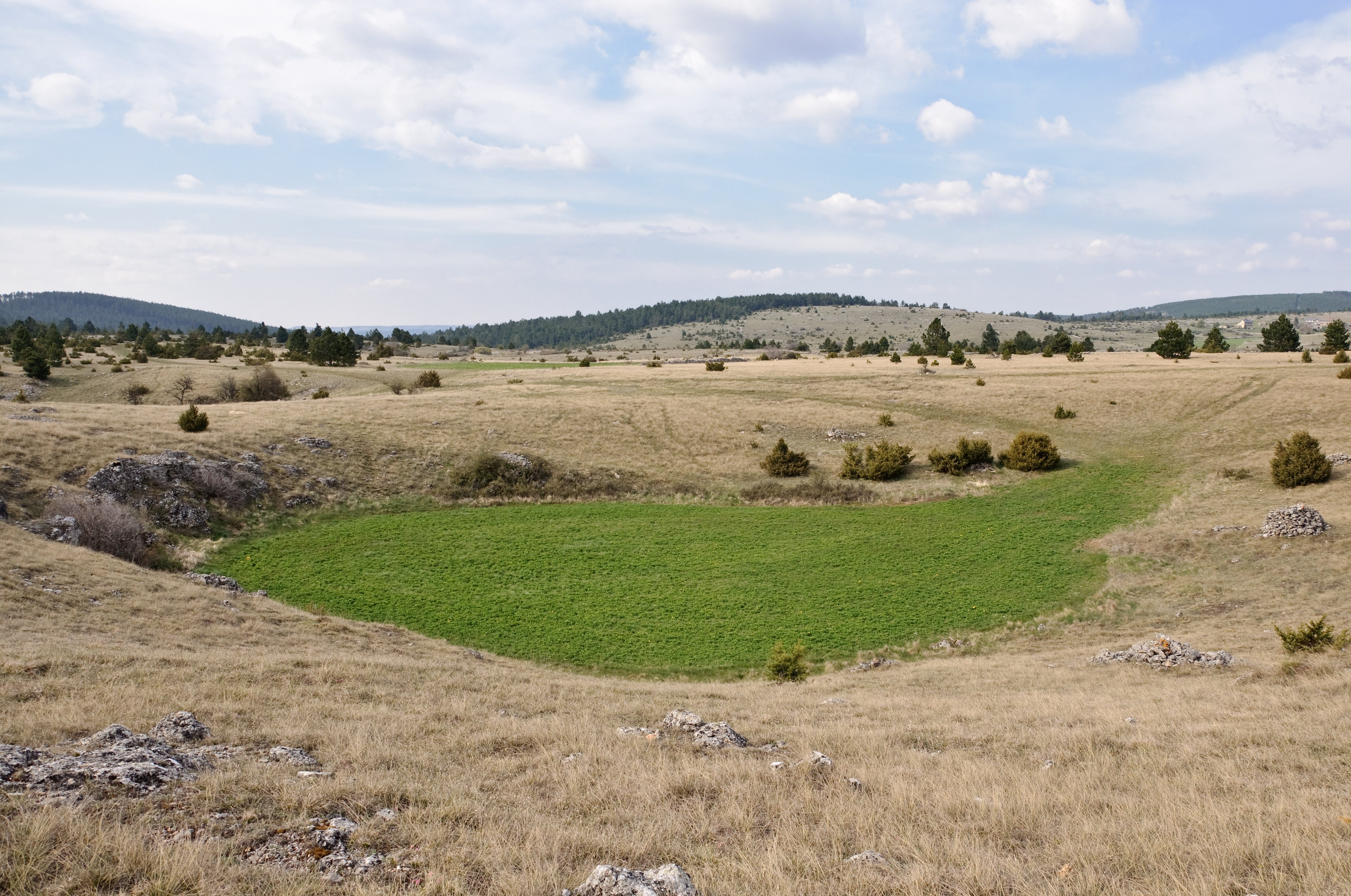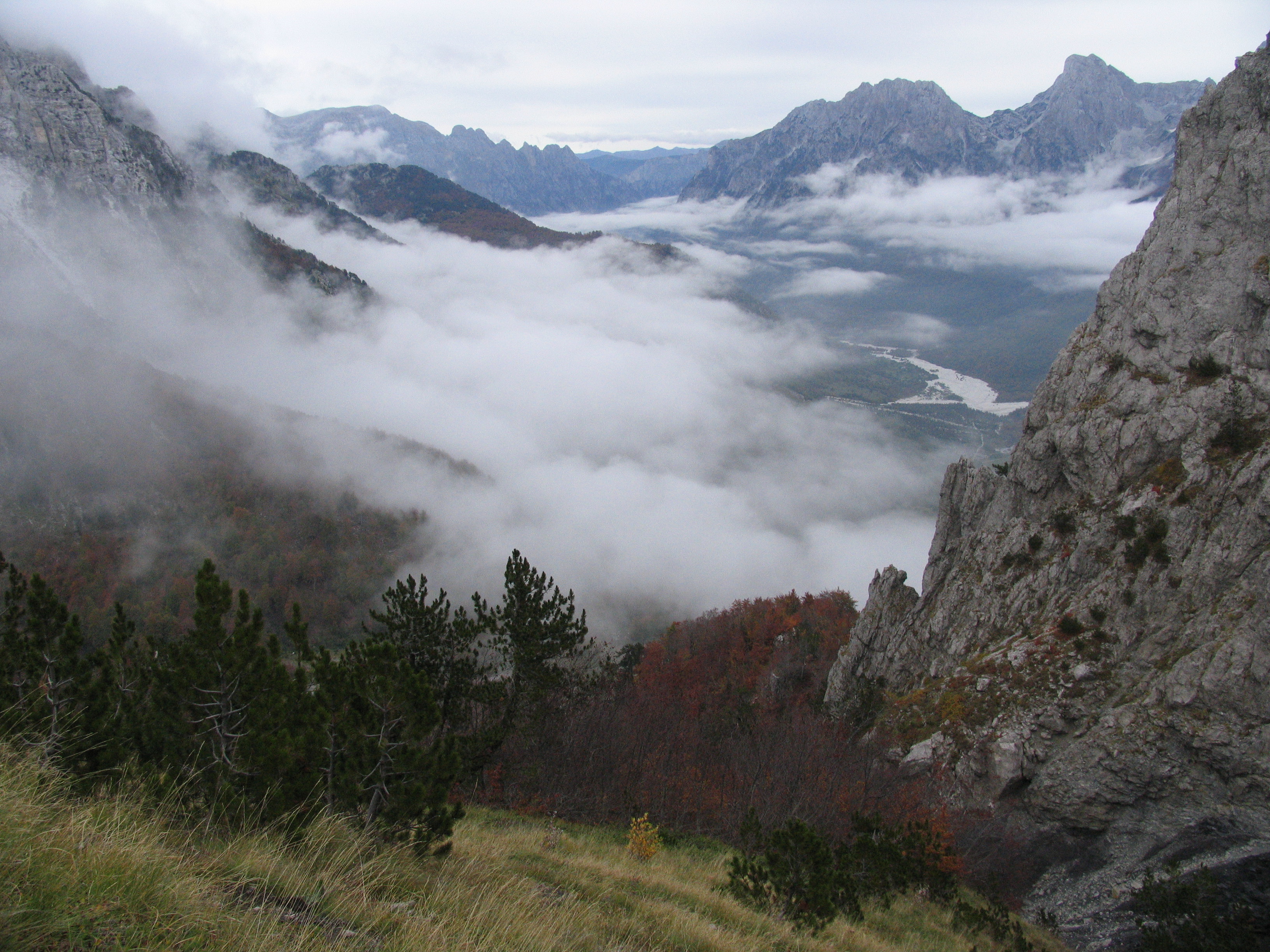|
Polje
A polje, also called karst polje or karst field, is a large flat plain found in karstic geological regions of the world, with areas usually in the range of 5–400 km2 (2–154 sq mi). The name derives from the Slavic languages, where ''polje'' literally means 'field', whereas in English ''polje'' specifically refers to a karst plain or karst field. Geology A polje, in geological terminology, is a large, flat-floored depression within karst limestone, whose long axis develops in parallel with major structural trends and can become several miles (tens of kilometers) long. Superficial deposits tend to accumulate along the floor. Drainage may be either by surface watercourses (as an ''open polje'') or by swallow holes (as a ''closed polje'') or ponors. Usually, the ponors cannot transmit entire flood flows, so many poljes become wet-season lakes. The structure of some poljes is related to the geological structure, but others are purely the result of lateral dissolut ... [...More Info...] [...Related Items...] OR: [Wikipedia] [Google] [Baidu] |
Popovo Polje
Popovo Polje ( sh-Latn-Cyrl, separator=" / ", Popovo polje, Попово поље, , is a '' polje'' (karstic field) in Bosnia and Herzegovina, located in a southernmost region of the country, near the Adriatic coast. Its size is . Popovo polje is one of the most famous ''polje'' (karstic plains) in Bosnia and Herzegovina and the world, for its karstic phenomenons and features, and particularly the Trebišnjica river, which flows through the polje as the largest sinking river (also ''losing stream'', or ''influent stream'') in the world, as well as the Vjetrenica cave system, located to the west/south-western parts of the valley. History The Nikolić noble family and Sanković noble family held Popovo polje in the late Middle Ages. The Vojnović noble family hailed from Popovo polje. The Zavala Monastery was first mentioned in the 16th century. At the end of Ottoman rule in Herzegovina, the Muslibegović family had properties in Popovo polje. The Zavala Monastery is locate ... [...More Info...] [...Related Items...] OR: [Wikipedia] [Google] [Baidu] |
Karst
Karst () is a topography formed from the dissolution of soluble carbonate rocks such as limestone and Dolomite (rock), dolomite. It is characterized by features like poljes above and drainage systems with sinkholes and caves underground. There is some evidence that karst may occur in more weathering-resistant rocks such as quartzite given the right conditions. Subterranean drainage may limit surface water, with few to no rivers or lakes. In regions where the dissolved bedrock is covered (perhaps by debris) or confined by one or more superimposed non-soluble rock strata, distinctive karst features may occur only at subsurface levels and can be totally missing above ground. The study of ''paleokarst'' (buried karst in the stratigraphic column) is important in petroleum geology because as much as 50% of the world's Oil and gas reserves and resource quantification, hydrocarbon reserves are hosted in carbonate rock, and much of this is found in porous karst systems. Etymology ... [...More Info...] [...Related Items...] OR: [Wikipedia] [Google] [Baidu] |
Karstic
Karst () is a topography formed from the dissolution of soluble carbonate rocks such as limestone and dolomite. It is characterized by features like poljes above and drainage systems with sinkholes and caves underground. There is some evidence that karst may occur in more weathering-resistant rocks such as quartzite given the right conditions. Subterranean drainage may limit surface water, with few to no rivers or lakes. In regions where the dissolved bedrock is covered (perhaps by debris) or confined by one or more superimposed non-soluble rock strata, distinctive karst features may occur only at subsurface levels and can be totally missing above ground. The study of ''paleokarst'' (buried karst in the stratigraphic column) is important in petroleum geology because as much as 50% of the world's hydrocarbon reserves are hosted in carbonate rock, and much of this is found in porous karst systems. Etymology The English word ''karst'' was borrowed from German in the late ... [...More Info...] [...Related Items...] OR: [Wikipedia] [Google] [Baidu] |
Logatec Polje
The Logatec Karst Field or Logatec Polje (; ) is a karst field near Logatec in southwestern Slovenia (the traditional region of Inner Carniola). Geographically, it corresponds to the floor of the Logatec Basin ().Oblak-Polajnar, Majda. 1959Logaška kotlina kot geografska individualnost ''Geografski vestnik'' 31: 19–44. It lies at an elevation between and Mihevc, Pavle. 1992. Logaško polje. ''Enciklopedija Slovenije'', vol. 6, p. 312. Ljubljana: Mladinska knjiga. and encompasses about of mostly grassy terrain. Logaščica Creek, a losing stream, runs across the karst field and collects ambient water. The karst field often flooded in the past, and so land improvement was carried out. The northern part of the Logatec Karst Field is called the Empty Karst Field () and the main road from Logatec to Vrhnika runs across it, passing through the linden-lined section known as the Napoleon Avenue (). The southern part of the karst field is known as the Lower Logatec Karst Field (), or ... [...More Info...] [...Related Items...] OR: [Wikipedia] [Google] [Baidu] |
Cerknica Polje
Lake Cerknica (; ) is an intermittent lake in the southern part of the Cerknica Polje, a karst polje in Inner Carniola, a region in southwestern Slovenia. Description The lake, oriented in the Dinaric Alps, Dinaric direction from north-west to south-east, is present for the most part of the year. When full, it is the largest lake in the country. The plain is surrounded by the Javornik Hills () to the south and Slivnica (mountain), Slivnica () to the north, both belonging to Dinaric Alps. The area of the lake mainly reaches , but can reach up to and the surface level varies from to above sea level. The largest settlement at the border of the lake is Cerknica, located north of the lake. Various watersports, including rowing, are popular on the lake. Environment The climate in the area is continental climate, continental, with a mean temperature of and the annual precipitation about . Botanically, the lake is distinguished by amphibious plants. It is therefore a part of two Natu ... [...More Info...] [...Related Items...] OR: [Wikipedia] [Google] [Baidu] |
Ličko Polje (Lika)
Ličko Polje () is a polje (karstic field) in the Lika region, located in Croatia. Being the largest in Croatia, the field covers an area of 465 km2, and consists of five smaller fields: Lipovo, Kosinjsko, Pazariško, Brezovo and Gospićko. The field is characterized by some inselberg An inselberg or monadnock ( ) is an isolated rock hill, knob, ridge, or small mountain that rises abruptly from a gently sloping or virtually level surrounding plain. In Southern Africa, a similar formation of granite is known as a koppie, an ...s, among them Zir (852 m), Otež (745 m) and Debeljak (882 m). The population is engaged in crops and farming. Largest settlement is Gospić. References {{Dinaric Alps' karst fields Plains of Croatia Geology of Croatia ... [...More Info...] [...Related Items...] OR: [Wikipedia] [Google] [Baidu] |
Glamoč
Glamoč ( sr-cyrl, Гламоч) is a town and the seat of the Municipality of Glamoč in Canton 10 of the Federation of Bosnia and Herzegovina, an entity of Bosnia and Herzegovina. It is situated in southwestern Bosnia and Herzegovina, at the foothills of Staretina and Velika Golija mountains, and on the edge of the central part of the ''Glamočko Polje''. Name During the Ottoman Empire, Ottoman era the town was recorded as Biograd (White town), Belgradčik and Biogradaz. Geography Climate The climate of Glamoč is classified as an oceanic climate (''Cfb'' in Köppen climate classification#Group C: Temperate/mesothermal climates, Köppen climate classification system), near the boundary of the humid continental climate. Glamoč has four separate seasons. Summers are warm, and winters are cold, without a discernible dry season. History The Glamoč area has been inhabited since at least Neolithic times. In the late Bronze Age, the Neolithic population was replaced by mo ... [...More Info...] [...Related Items...] OR: [Wikipedia] [Google] [Baidu] |
Dinaric Alps
The Dinaric Alps (), also Dinarides, are a mountain range in Southern Europe, Southern and Southcentral Europe, separating the continental Balkan Peninsula from the Adriatic Sea. They stretch from Italy in the northwest through Slovenia, Croatia, Bosnia and Herzegovina, Serbia, Montenegro, and Kosovo to Albania in the southeast. The Dinaric Alps extend for approximately along the western Balkan Peninsula from the Julian Alps of the northeast Italy, downwards to the Šar Mountains, Šar and Korab (mountain), Korab massif, where their direction changes. The Accursed Mountains are the highest section of the entire Dinaric Alps; this section stretches from Albania to Kosovo and eastern Montenegro. Maja Jezercë, standing at Metres above the Adriatic, above the Adriatic, is the highest peak and is located in Albania. The Dinaric Alps are one of the most rugged and extensive mountainous areas of Europe, alongside the Caucasus Mountains, Alps, Pyrenees, Carpathian Mountains and Scand ... [...More Info...] [...Related Items...] OR: [Wikipedia] [Google] [Baidu] |
Nevesinje
Nevesinje ( sr-cyrl, Невесиње) is a town and municipality in Republika Srpska, Bosnia and Herzegovina. As of 2013, the town has a population of 5,162 inhabitants, while the municipality has 12,961 inhabitants. Geography The municipality of Nevesinje covers and is located in the south of Bosnia and Herzegovina. A large polje called Nevesinjsko polje dominates the municipality, and is encircled by the mountains of Crvanj to the north and northeast, Prenj to the northwest, and Velež (Bosnia and Herzegovina), Velež to the south and southwest. The entire municipality, as well as the entire region of eastern Herzegovina beyond municipal borders, has an average elevation of above sea level. History Annals of the Patriarchal Monastery of Peć mentioned Nevesinje in 1219, which is the earliest mention of Nevesinje in preserved historical sources. The ''župa'' (county) of Nevesinje was held by Serbian prince Stefan Konstantin between 1303–06. The Chronicle of the Priest of ... [...More Info...] [...Related Items...] OR: [Wikipedia] [Google] [Baidu] |
Nikšić
Nikšić (Cyrillic script, Cyrillic: Никшић, ), is the second largest city in Montenegro, with a total population of 32,046 (2023 census) located in the west of the country, in the centre of the spacious Nikšić field at the foot of Trebjesa Hill. It is the center of Nikšić Municipality with population of 65,705 according to 2023 census, which is the largest municipality by area and second most inhabited after Podgorica. It was also the largest municipality by area in the former Yugoslavia. It is an important industrial, cultural, and educational center. Name In classical antiquity, the area of Nikšić was the site of the settlement of the Illyrians, Illyrian tribe of the Endirudini and was known in sources of the time as Anderba or Enderon. The Roman Empire built a Castra, military camp (''castrum Anderba'') in the 4th century AD, which was known as the Ostrogothic fortress ''Anagastum'' (after 459. AD). After Slavic settlement in the region, Anagastum became Slavic ''Ono ... [...More Info...] [...Related Items...] OR: [Wikipedia] [Google] [Baidu] |
Krbava
Krbava (; ) is a historical region located in Mountainous Croatia and a former Catholic bishopric (1185–1460), precursor of the diocese of Modruš and present Latin titular see. It can be considered either located east of Lika, or indeed as the eastern part of Lika. The town of Udbina is the central settlement of the Krbava karst field, the Krbavsko Polje. History Overview Krbava was one of twelve medieval regions that later comprised the later Lika-Krbava County. Numerous historical sources, mainly in Latin, referred to toponyms within Krbava, most of which have been correlated with modern-day toponymy. The most important historical event in Krbava was the Battle of Krbava Field in 1493. During Croatia in the union with Hungary, nobility were given the title "of Krbava" (''de Corbauia''). Ecclesiastical history * Its capital Udbina became the seat of a Catholic bishopric of Corbavia (Latin = Curiate Italian) / Corbavien(sis) (Latin adjective) when the council ... [...More Info...] [...Related Items...] OR: [Wikipedia] [Google] [Baidu] |




